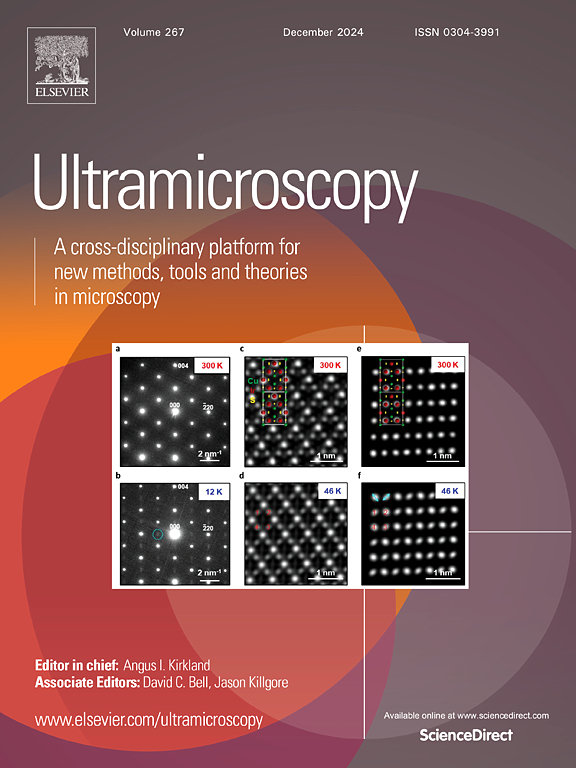Ultra-thin plan-view lamella made by focused ion beam
IF 2
3区 工程技术
Q2 MICROSCOPY
引用次数: 0
Abstract
Understanding and controlling microstructure is critical for a wide range of functional materials, where properties such as ferroelectricity, conductivity, and catalytic activity are tightly coupled to nanoscale features like grain size, phase distribution, and interfaces. However, rigorous microstructural characterization is often hindered by the ultrathin geometries, nanocrystalline domains, and structural polymorphism inherent to these materials. Hafnium zirconium oxide (Hf₀.₅Zr₀.₅O₂, HZO) is an exemplar case: a leading ferroelectric oxide for next-generation embedded memory, storage and DRAM like applications, whose performance is strongly microstructure-dependent. Among available techniques, transmission electron microscopy (TEM) provides the most direct access to HZO’s nanometer-scale structure—TEM imaging reveals grain morphology, while nanobeam electron diffraction (NBED) distinguishes among its subtle polymorphs. However, conventional cross-sectional focused-ion-beam (FIB) lamellae often obscure such details due to limited field of view and through-thickness grain overlap. In contrast, plan-view lamellae isolate the target ultrathin film, enabling single-grain NBED and large-area imaging. In this study, we detail a refined focused-ion-beam (FIB) workflow for producing electron-transparent, plan-view lamellae from ∼10 nm-thick HZO films grown on Si substrates. The pivotal step is a low-kV fine-thinning sequence designed to maximize the preserved HZO area while minimizing ion-induced damage. This progress is tracked in situ by monitoring contrast changes in the scanning electron microscope (SEM) and verified ex situ with energy-dispersive X-ray spectroscopy (EDS). Referenced to an adjacent unthinned region, quantitative scanning transmission electron microscopy (STEM) imaging combined with EDS confirms a reproducible taper from the native 10 nm thickness to 3–4 nm at the lamella edge, all while maintaining atomic-column integrity. This workflow enables unambiguous polymorph identification and provides a robust platform for correlating microstructure with ferroelectric functionality in HZO and related ultrathin oxides—an essential step toward evaluating the performance of fluorite-based ferroelectric devices.
由聚焦离子束制成的超薄平面层
了解和控制微观结构对于各种功能材料至关重要,其中铁电性、电导率和催化活性等特性与晶粒尺寸、相分布和界面等纳米尺度特征紧密相关。然而,严格的微观结构表征往往受到这些材料固有的超薄几何形状、纳米晶畴和结构多态性的阻碍。氧化铪锆(Hf 0 .₅Zr 0 .)₅O₂(HZO)就是一个例子:一种领先的铁电氧化物,用于下一代嵌入式内存、存储和DRAM等应用,其性能强烈依赖于微结构。在现有的技术中,透射电子显微镜(TEM)提供了对HZO纳米级结构的最直接的访问- TEM成像揭示了颗粒形态,而纳米束电子衍射(NBED)区分了其微妙的多晶型。然而,传统的横截面聚焦离子束(FIB)薄片由于视野有限和晶粒厚度重叠,往往掩盖了这些细节。相比之下,平面视图片层隔离了目标超薄薄膜,实现了单粒NBED和大面积成像。在这项研究中,我们详细介绍了一种精细的聚焦离子束(FIB)工作流程,用于从生长在Si衬底上的~ 10nm厚的HZO薄膜中生产电子透明的平面视图片。关键步骤是低kv细稀释序列,旨在最大限度地保留HZO区域,同时最大限度地减少离子引起的损伤。通过监测扫描电子显微镜(SEM)的对比度变化来原位跟踪这一进展,并通过能量色散x射线光谱(EDS)进行非原位验证。参考相邻的未薄化区域,定量扫描透射电子显微镜(STEM)成像结合EDS证实了从原始10 nm厚度到片层边缘3-4 nm的可再生锥度,同时保持原子柱的完整性。该工作流程实现了明确的多晶型识别,并为HZO和相关超薄氧化物中与铁电功能相关的微观结构提供了一个强大的平台,这是评估萤石基铁电器件性能的重要一步。
本文章由计算机程序翻译,如有差异,请以英文原文为准。
求助全文
约1分钟内获得全文
求助全文
来源期刊

Ultramicroscopy
工程技术-显微镜技术
CiteScore
4.60
自引率
13.60%
发文量
117
审稿时长
5.3 months
期刊介绍:
Ultramicroscopy is an established journal that provides a forum for the publication of original research papers, invited reviews and rapid communications. The scope of Ultramicroscopy is to describe advances in instrumentation, methods and theory related to all modes of microscopical imaging, diffraction and spectroscopy in the life and physical sciences.
 求助内容:
求助内容: 应助结果提醒方式:
应助结果提醒方式:


